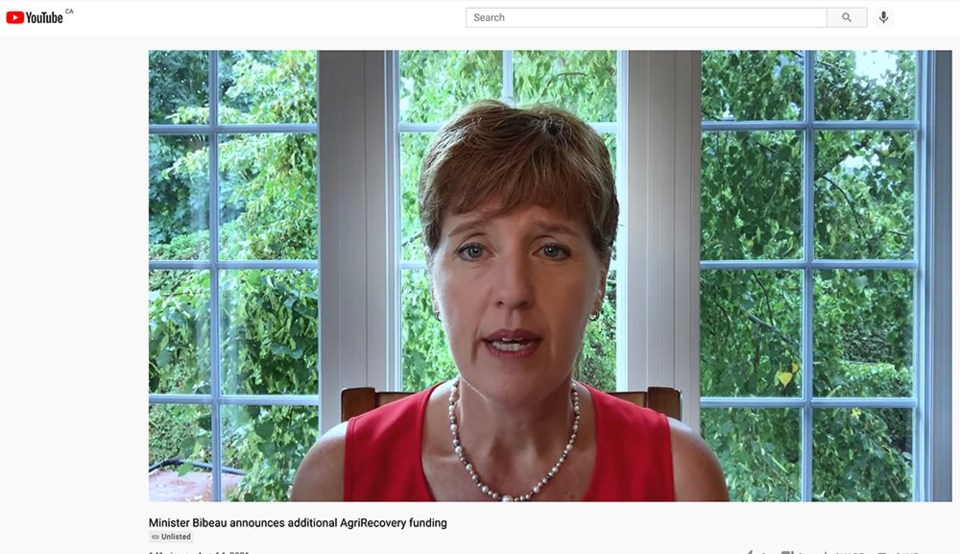The federal government has committed more funds under the AgriRecovery program. The announcement came just hours before a national election was called.
"I am announcing that we are boosting that commitment to up to half a billion dollars," said federal Agriculture Minister Marie-Claude Bibeau in a statement posted to YouTube.
The announcement comes a little more than a week after the federal government released $100 million in funding under AgriRecovery. And it comes only days after Alberta, Saskatchewan, Manitoba and Ontario upped the ante on their respective commitments to the program to $322 million combined.
"This funding ensures that the federal government is ready to contribute our full 60 per cent share towards cost-shared AgriRecovery program," said Bibeau in her statement.
The $500 million will match the provincial contributions by the three prairie provinces and Ontario. The program splits contributions between Ottawa and the provinces with the latter picking up 40 percent.
Bibeau stated, "we are working around the clock to launch support programs as soon as possible. This will include direct assistance to producers for extra costs including livestock feed, transportation and water."
The funding comes as grain growers and cattle producers are reeling from drought and wildfires stretching from the West Coast to Thunder Bay, Ont.
Bob Lowe, president of the Canadian Cattlemen's Association, said the scope of the two environmental disasters is something he has never before come across.
The AgriRecovery funding will be imperative in maintaining the national cattle inventory just as demand is rising and the domestic herd is shrinking, said Lowe.
"Our herd never built after BSE. That hit people so hard that a lot of people exited the industry," said Lowe, highlighting the 15-year decline in Canada's cattle inventory. He added this year's total reductions may be substantial. And a solution to stemming the slide would be to provide aid to all producers so they have opportunity to increase their herds.
"We don't know how this money is going to roll out yet but what we'd like to see is that it be every single cow (that would be eligible)," said Lowe. "That would do more to retain the herd than just trying to pick who is worse. This isn't a time for pinching pennies for a government if you want to look out for an industry."
More aid will likely be needed, said Lowe, but the current best forecasts of where the market is going would see government investment now pay off in the long run.
"This industry is going nowhere but up," he said, citing herd reductions in the U.S., South America and Australia. "If we can get through this and save as much cows as we can, I'm convinced that will be a really strong signal that we need to rebuild this herd."
Saskatchewan and Manitoba each announced respective Agri- Recovery commitments of $119 million and $62 million a few days following Alberta's pledge earlier this month of $136 million towards the program and Ontario's $5 million. Saskatchewan Agriculture Minister David Marit stated that province will seek to provide an initial $100-a-head payment for breeding females. That would be followed by a second payment.
"Pending federal review of our proposal, a second $100 instalment would be issued later based on the number of breeding animals still on the farm at the end of the calendar year," said Marit.
David Flundra, who attended the announcement and who ranches in southwest Saskatchewan, said the economics will be tough even with the assistance because feed costs are usually around $500-perhead over winter.
"But this isn't going to be an ordinary winter. You could probably add a month on each end because what we're grazing on now is going to affect us next spring," he said.
Flundra is getting quotes for costs up to $4 per head per day or more for cattle placed in area feedlots. "I'm not a big operator but I'm running 300 cows. You take those 300 cows — trying to find a place for them whether you buy the feed for them or whether I put them in a feedlot — at the end of the day that adds up," he said.
Alberta's Agriculture Financial Services Corp., will administrate the province's $94-per-head initial AgriRecovery payment and stated it hopes to have the applications ready by early September.
AFSC's Emmet Hanrahan stressed eligibility for those funds will be focused on maintaining Alberta's female breeding stock inventory.
"Selling heifers into a meat market or slaughter market, then no, they are not eligible and we don't want to be paying on couples either," said the AFSC vice-president of product development.
Alberta will disburse a subsequent $106 per head under a receipt-based payment before the end of the year. The federal funding will be shared across the western provinces and northwestern Ontario.
The $500 million announced by the federal government includes the previously committed $100 million.
Contact [email protected]

